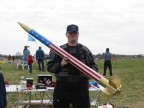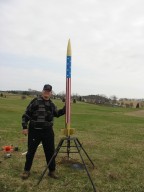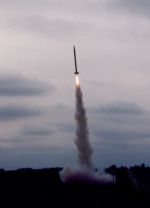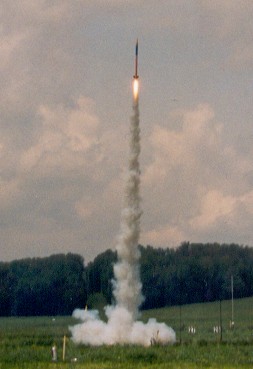 The American Spirit started life as a LOC Ultimate. I received
it as a Christmas gift in 1997, building it that winter, and launched it once
in Denver, PA with a G80-4T. Mr. Reed, one of the Technology teachers in my
High school borrowed it for his families Memorial Day picnic, and flew it on a
G80. Then my Ultimate made the journey to my new home in New Hampshire. The American Spirit started life as a LOC Ultimate. I received
it as a Christmas gift in 1997, building it that winter, and launched it once
in Denver, PA with a G80-4T. Mr. Reed, one of the Technology teachers in my
High school borrowed it for his families Memorial Day picnic, and flew it on a
G80. Then my Ultimate made the journey to my new home in New Hampshire.
April 19th, 1999, the Ultimate once again saw the light of Day, launching on
yet another G80 in Amesbury, Mass, at my first CMASS launch. At the same
launch, someone sold me a RMS 29/180 and 240 set for a real good price, and
Steven Boy sold me a H97. I loaded it into my Ultimate, and gained my level 1.
The Ultimate launched again with a G75, and then had its final flight… two
F25-9W’s and a single G75-10J. Beautiful flight, but suffered a sep. The
payload section drifted away, never to be seen again. The booster section came
in ballistic, smashing the tubing up to the forward centering ring,
and knocking a couple of the fins off.
 After the
events of 9-11, I decided that I wanted to build a patriotic rocket. Having no
money to buy a new large rocket, I decided to repair use what was left of the
fin can of the Ultimate, and created a new rocket, which I called the American
Spirit. I took the fin can, and removed the remaining attached fins, and sanded
down all the epoxy. Then I cut off the damage tubing above the forward launch
lug, which left about three inches of damaged tubing beyond the forward
centering ring. After the
events of 9-11, I decided that I wanted to build a patriotic rocket. Having no
money to buy a new large rocket, I decided to repair use what was left of the
fin can of the Ultimate, and created a new rocket, which I called the American
Spirit. I took the fin can, and removed the remaining attached fins, and sanded
down all the epoxy. Then I cut off the damage tubing above the forward launch
lug, which left about three inches of damaged tubing beyond the forward
centering ring.
Since the original fins were still in good shape, I reattached them, and did
the usual epoxy and bondo fillets to give a good finish. Then I epoxied a tube
coupler into the airframe above the centering ring, and then attached a two
foot section of LOC 4” dia tube to it. I then took a razor blade, and cut
off the remaining raised areas of the damaged body tube. Then I filled the
valleys created with epoxy and bondo. I used the remaining 4” tubing to
create the payload bay, which was attached via a standard tube coupler. For the
nosecone, I use the NCR cone from my expired Archer. I also used the parachute
from my Archer for its recovery system.
Painting the American Spirit was a challenge. I wanted to do an American
Flag theme. So I decided to do the stripes down the body, and put the stars on
the payload section. To make things simple with the nose and tail, I decided to
paint those gold. First step was to paint the entire rocket white. Then I used
masking tape to mask the stripes, thinking of a white and red stripe between
each fin (6 fins, that equals 12 stripes). For the starts, I printed out a
bunch of stars on label paper, cut them out by hand, and painstakingly position
them on the payload tube. I lined up the top of the “arms” with one
of the fins, so there are 6 rows of stars, alternating between three and four
stars per row. There are 21 stars total. The booster was then sprayed with red
paint, and the payload section with blue. Then the fin can, and nose was
painted Gold. Shortly after this, I learned that Gold Paint does not take to
well to clear coat. Oh well…
 First flight of the American Spirit took place on the dark
and cold day of April 19th, 2002. I planned to fly it on a H220-10T…
perfect day for a Blue Thunder motor. Then I noticed that both my friend Ryan
Sebastian and I had E23-8T loads. Wanna put them in the American Spirit? Why
Not? So we did. We could not see the flames of the E23's, but it was cool to
hear the E23's thrusting for a whole second after the WHAM of the H220’s
burn. First flight of the American Spirit took place on the dark
and cold day of April 19th, 2002. I planned to fly it on a H220-10T…
perfect day for a Blue Thunder motor. Then I noticed that both my friend Ryan
Sebastian and I had E23-8T loads. Wanna put them in the American Spirit? Why
Not? So we did. We could not see the flames of the E23's, but it was cool to
hear the E23's thrusting for a whole second after the WHAM of the H220’s
burn.
Second flight was on July 27th, 2002. Loaded to bear with more power. Ryan
Sebastian and I once again collaborated together to put this beast up on more
then one motor. In the center, an H128-10W. On the outboards, two
G64-10W’s. Three Magnelites were used to get the rocket going, and it was
an AWESOME flight. Lots of fire, lots of smoke, and lots of noise. It is also
very interesting to see the reduction of the fire and smoke once the shorter
burning H128 ran out of fuel.
Some minor repairs were required after the last flight; one of the fins
stabbed the payload section. This was easily repaired by putting some masking
tape underneath the wound, and filling the puncture with epoxy. Also, since the
payload bay was getting a little surgery done to it, I decided to drill the
holes and cut the panels in the aft end so it can accept my 4” electronics
bay to incorporate dual deployment into this rocket. The 4” electronics
bay has a $65 Transolve PK altimeter, and it has performed flawlessly in my
EZI-65 and MEGABLAST L2 rocket.
 Next flight took place on April 19th, 2003. A
central G35-7W surrounded by three G35-7W motors were instantly ignited by
Magnelite igniters, and the resulting liftoff was very spectacular. I plugged
the ejection wells of the G motors, so recovery was provided by the altimeter.
Once again, it function flawlessly. Next flight took place on April 19th, 2003. A
central G35-7W surrounded by three G35-7W motors were instantly ignited by
Magnelite igniters, and the resulting liftoff was very spectacular. I plugged
the ejection wells of the G motors, so recovery was provided by the altimeter.
Once again, it function flawlessly.
The most recent flight of the American Spirit took place during NSL 2003 in
Clarks Summit, PA. She was loaded to bare seven G35-7W motors. The largest
cluster I have ever done. All seven motors ignited instantly with Magnelite
igniters, and the Transolve altimeter did its job. However, the main chute got
tangled, and it landed with a thud in the tall grass. Fortunately, there was no
damage. The video of this flight made it on the NSL 2003 DVD.
I do plan to fly the American Spirit again in the future, but as you can
imagine, clustering composite motors can become pricey. Maybe one of these
days, when I have more money to burn, I will build a beefed up version, and
launch it on a cluster of seven I200’s. Imagine the size of flame that
cluster would produce! That will be equivalent to a K1400! Almost a full K!
|


















